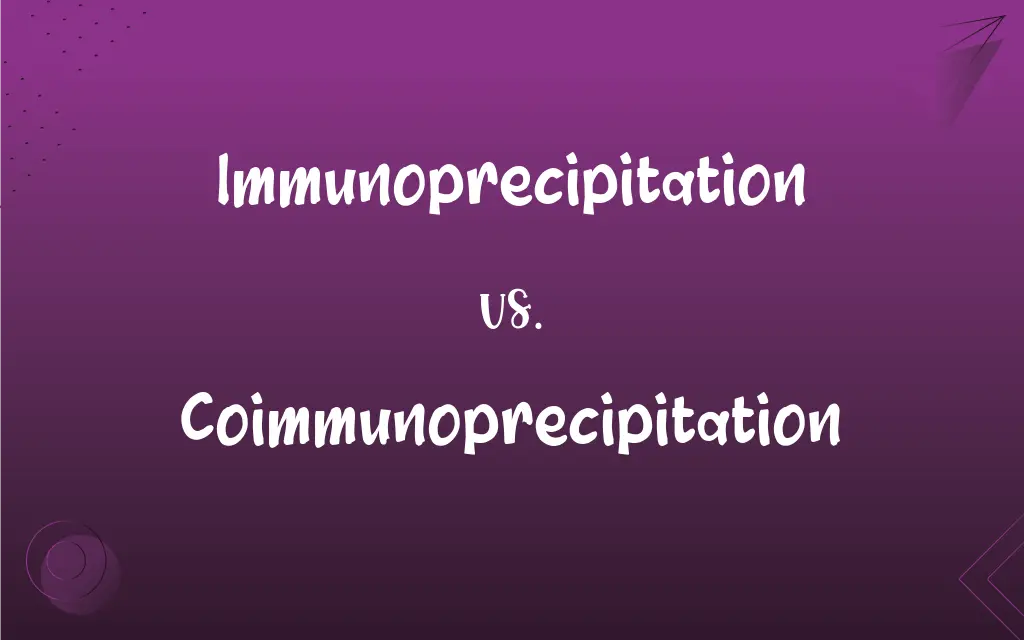Immunoprecipitation vs. Coimmunoprecipitation: What's the Difference?
Edited by Aimie Carlson || By Janet White || Published on March 2, 2024
Immunoprecipitation is a technique to isolate a specific antigen using an antibody, while coimmunoprecipitation isolates an antigen along with its interacting proteins.

Key Differences
Immunoprecipitation (IP) is a widely used technique in molecular biology to isolate and concentrate a specific protein from a sample by using an antibody that specifically binds to that protein. This process effectively separates the protein of interest from the rest of the sample, allowing for further analysis, such as western blotting or mass spectrometry. Coimmunoprecipitation (Co-IP), on the other hand, extends the principle of IP to not only isolate the primary antigen but also any proteins that are bound to it or interacting with it. This makes Co-IP a powerful tool for studying protein-protein interactions within a complex biological sample.
The primary difference between IP and Co-IP lies in their applications. IP is focused on the purification of a single protein for the purpose of identifying it or analyzing its properties, such as its size or post-translational modifications. Co-IP, however, is used when the goal is to identify potential interaction partners of the protein of interest, providing insights into the protein's function within the cell or signaling pathways it may be involved in.
Both techniques require the formation of an antigen-antibody complex, but the choice of antibody is crucial in Co-IP experiments to ensure that the protein of interest can still interact with its partners. In IP, the interaction between the protein and its antibody is the sole focus, whereas in Co-IP, the antibody must not obstruct the protein's interaction sites.
IP is a straightforward approach to studying proteins, Co-IP adds a layer of complexity by requiring subsequent analyses to confirm the identity and relevance of the co-precipitated proteins. This often involves additional steps such as mass spectrometry or further biochemical assays to validate the interactions detected.
Comparison Chart
Objective
To isolate a specific protein using an antibody.
To isolate a protein along with its interacting partners.
ADVERTISEMENT
Primary Application
Analysis of a single protein's properties.
Study of protein-protein interactions.
Antibody Requirement
Antibody specific to the target protein.
Antibody that allows the target protein to interact.
Complexity
Relatively straightforward.
More complex, involves identifying multiple proteins.
Outcome
Isolated antigen.
Antigen plus associated proteins.
Immunoprecipitation and Coimmunoprecipitation Definitions
Immunoprecipitation
A process involving the formation of an antibody-antigen complex to isolate proteins.
The immunoprecipitation step was crucial for detecting the phosphorylated form of the protein.
ADVERTISEMENT
Coimmunoprecipitation
A method to isolate a protein along with its binding partners from a sample.
Coimmunoprecipitation revealed the interaction between the transcription factor and its coactivator.
Immunoprecipitation
A method for concentrating and purifying proteins of interest from biological samples.
Following immunoprecipitation, the protein's purity was confirmed via SDS-PAGE.
Coimmunoprecipitation
A strategy for identifying functional partnerships between proteins in cellular processes.
The interaction between the kinase and its substrate was confirmed by coimmunoprecipitation.
Immunoprecipitation
A biochemical technique used to study protein expression and modifications.
Immunoprecipitation enabled the identification of post-translational modifications on the receptor.
Coimmunoprecipitation
A process that captures both a target antigen and associated molecules through antibody binding.
Coimmunoprecipitation was instrumental in mapping the components of the receptor complex.
Immunoprecipitation
A technique to isolate a specific antigen from a mixture using a targeted antibody.
Immunoprecipitation was used to purify the enzyme from cell lysates.
Coimmunoprecipitation
A technique for studying protein-protein interactions within complex biological systems.
Using coimmunoprecipitation, the team identified a previously unknown signaling pathway.
Immunoprecipitation
A laboratory procedure for extracting a target protein from a complex mixture.
The researcher performed immunoprecipitation to isolate the viral protein from infected cells.
Coimmunoprecipitation
A laboratory technique used to pull down an antigen along with its interactome.
Coimmunoprecipitation helped to elucidate the protein network involved in DNA repair.
Immunoprecipitation
(immunology) A technique in which an antigen is precipitated from solution by using an antibody, or a particular use of this technique.
We carried out sequential immunoprecipitations of cell lysates.
Coimmunoprecipitation
(immunology) The immunoprecipitation of multiple antigens at the same time
FAQs
How does coimmunoprecipitation differ from immunoprecipitation?
Co-IP is used to isolate a protein and its interacting partners, whereas IP focuses on a single protein.
Is it possible to identify post-translational modifications using immunoprecipitation?
Yes, IP can be used to isolate proteins for analysis of post-translational modifications.
What is the main purpose of immunoprecipitation?
To isolate and study a specific protein from a complex sample.
Can immunoprecipitation be used to study protein interactions?
IP primarily isolates a single protein; Co-IP is better suited for studying protein interactions.
What type of antibody is preferred for coimmunoprecipitation?
An antibody that binds the target protein without obstructing its interaction sites.
What are the limitations of immunoprecipitation?
IP may not capture proteins with weak or transient interactions well.
What samples are suitable for immunoprecipitation and coimmunoprecipitation?
Cell lysates, tissue extracts, and other complex biological samples.
Can immunoprecipitation be quantitative?
While primarily qualitative, quantitative approaches can be integrated, such as by using labeled antibodies.
How do you choose between immunoprecipitation and coimmunoprecipitation?
The choice depends on whether studying a single protein or protein interactions is the goal.
Are there any specific buffers recommended for immunoprecipitation?
Yes, buffers should be chosen based on the antibody and protein properties to preserve interactions and functionality.
Can coimmunoprecipitation confirm direct protein-protein interactions?
Co-IP suggests interactions but further experiments are needed to confirm direct interactions.
How do you verify the results of coimmunoprecipitation?
Verification typically involves western blotting, mass spectrometry, or additional biochemical assays.
How do you optimize immunoprecipitation conditions?
Optimization may involve adjusting antibody/protein ratios, buffer conditions, and incubation times.
How does coimmunoprecipitation contribute to understanding cellular signaling pathways?
By identifying interacting proteins, Co-IP provides insights into the dynamics and regulation of signaling pathways.
What challenges might one face when performing coimmunoprecipitation?
Identifying true interactions versus background noise can be challenging.
Can immunoprecipitation be used with any protein of interest?
In principle, yes, if a specific antibody against the protein is available.
What is the significance of wash steps in immunoprecipitation?
Wash steps remove non-specifically bound proteins to enrich for the protein of interest.
How important is the choice of antibody in Co-IP?
Critical, as it must specifically bind the target without preventing its interactions.
Can both techniques be automated?
Automation is possible, though it may require specialized equipment and protocols.
What is the role of the control in immunoprecipitation experiments?
Controls are crucial for distinguishing specific from non-specific binding.
About Author
Written by
Janet WhiteJanet White has been an esteemed writer and blogger for Difference Wiki. Holding a Master's degree in Science and Medical Journalism from the prestigious Boston University, she has consistently demonstrated her expertise and passion for her field. When she's not immersed in her work, Janet relishes her time exercising, delving into a good book, and cherishing moments with friends and family.
Edited by
Aimie CarlsonAimie Carlson, holding a master's degree in English literature, is a fervent English language enthusiast. She lends her writing talents to Difference Wiki, a prominent website that specializes in comparisons, offering readers insightful analyses that both captivate and inform.































































